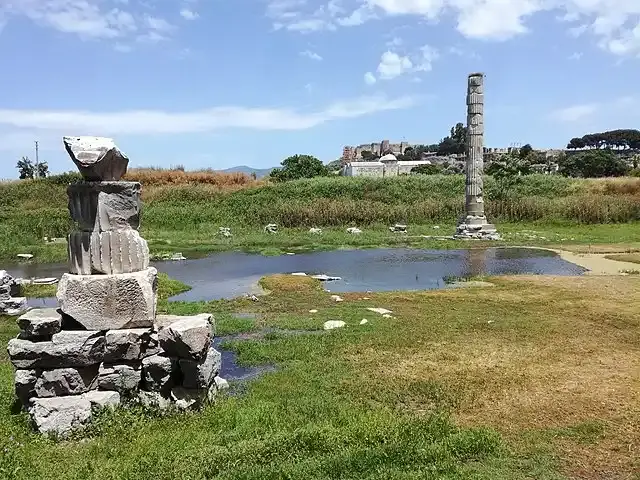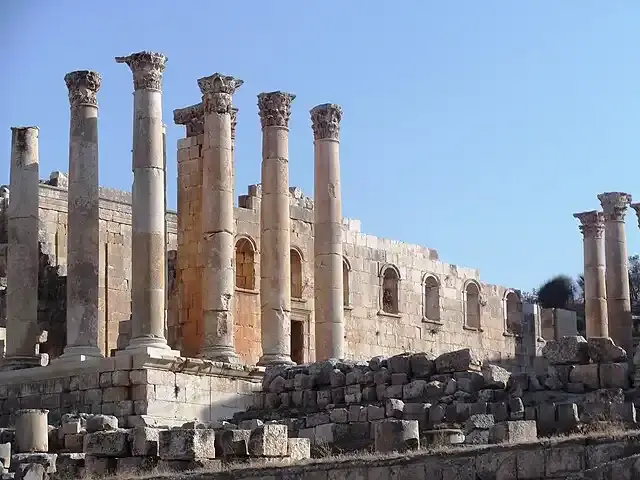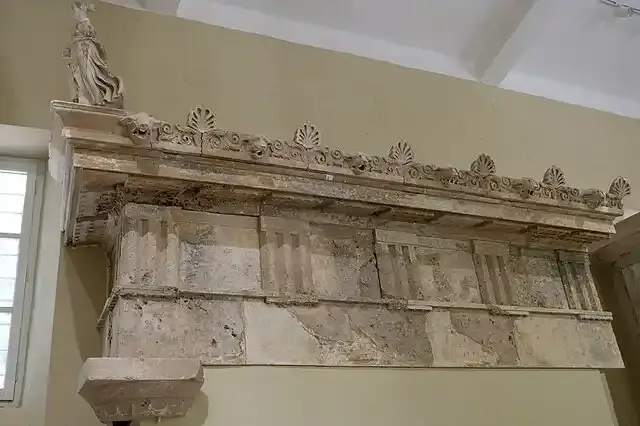The Search for the Lost Temple of Artemis: A Journey Through Time and Secrets
The Temple of Artemis, one of the Seven Wonders of the Ancient World, is a symbol of grandeur and devotion, although some of its history has been lost. His story is not only about his physical structure, but also about the cultural and religious significance he had for the ancient world. This article embarks on a journey through history, architecture, cultural influence, and the ongoing quest to rediscover the lost Temple of Artemis.
1. The location and geography of the Temple of Artemis.

The temple of Artemis was located in the ancient city of Ephesus, near the modern city of Selcuk in present-day Turkey. Ephesus was a busy city and a major center of commerce, culture, and religion in the ancient world. The temple itself was located on low-lying marshy land near the Cayster River (now known as the Küçükmenderes River). This strategic location was not only easily accessible by road, but was also close to the Aegean Sea, allowing easy access for pilgrims and merchants alike. The geography of the region, with its fertile plains and proximity to water, contributed to the prosperity of Ephesus, making it an ideal location for such a magnificent structure.
Recommend
2. History of the Temple of Artemis.

The Temple of Artemis has a long and rich history. The oldest temple at the site dates back to about 800 BC, but the most famous version, the great temple known as Artemision, was completed around 550 BC. This temple was built at the request of Croesus, the wealthy king of Lydia, and was designed by the Greek architect Chersiphron and his son Metagenes. It was a site of worship dedicated to Artemis, the Greek goddess of hunting, wilderness and fertility. The temple was destroyed over the centuries and rebuilt several times due to natural disasters, such as floods and earthquakes, as well as human actions, including the arson of Herostratus in 356 BC, who sought fame by burning the temple.
3. Geometry of the Temple of Artemis.

The Temple of Artemis was an architectural marvel of his time, embodying the grandeur of the Ionic engineering system. The structure is about 115 meters long and 46 meters wide, with more than 127 columns, each 18.30 meters high. These columns are decorated and decorated with intricate reliefs, and the temple is decorated with sculptures and inscriptions depicting different scenes from mythology and everyday life. The ceiling was made of marble tiles, and the entire structure was designed to create a sense of awe and respect. The huge size of the temple and elaborate decorations were intended to reflect the power and greatness of the goddess Artemis.
4. The role and value of the Temple of Artemis.
The Temple of Artemis was not only a religious center, but also a symbol of Ephesus' wealth and influence. It served as a haven for people from all over the ancient world to worship Artemis, seeking its protection and approval. The temple also served as the main financial institution, where wealth was stored and loans were granted. His role extended far beyond religion; it was a place of cultural exchange, where ideas, arts and commerce met. The value of the temple was spiritual and economic, making it a vital part of Ephesians' identity.
5. The Temple of Artemis is lost.
Despite its grandeur, the temple of Artemis could not withstand the forces of time and human aggression. After being rebuilt after arson in 356 BC, the temple was again damaged by the Goths during their conquest in 268 AD. However, it was the rise of Christianity and the subsequent decline of paganism that eventually led to the temple's demise. By the end of the fourth century CE, the temple had fallen into disrepair, and its materials had been reused to build other buildings. The great temple was gradually lost in history, buried under centuries of soil and forgotten.
6. Search for the lost temple of Artemis.
The search for the lost temple of Artemis began in earnest in the nineteenth century, motivated by the desire to uncover the remains of one of the Seven Wonders of the World. British archaeologist John Turtle Wood led the first successful expedition, and the foundations of the temple were discovered in 1869 after years of painstaking work. His discoveries reignited interest in the site, leading to further excavations in the twentieth and twenty-first centuries. Despite these efforts, much of the temple is still buried, and the search for the discovery of its full glory continues to this day, as contemporary archaeologists use advanced technology to explore the site.
7. The current status of the Temple of Artemis.
Today, only a few scattered ruins remain from the great temple of Artemis. This site includes one reconstructed column, a few scattered stones, and the foundation of the temple, indicating the greatness that once stood there. The site is now an archaeological park, attracting tourists and scholars seeking to connect with the ancient past. Ongoing excavations and research continue to reveal new insights into the temple's history and significance, keeping the legacy of Artemis and its temple alive.
8. The tourist and cultural significance of the Temple of Artemis.

The Temple of Artemis has enormous tourist and cultural significance as a symbol of the architectural and religious achievements of the ancient world. Every year, thousands of visitors from all over the world travel to Selcuk to explore the ruins and the nearby Ephesus Archaeological Museum, which houses many artifacts from the site. The story of the temple is also a vital part of local culture, celebrated at festivals and events that honor Ephesus' rich history. The site acts as a bridge between the past and the present, offering a glimpse into the world of ancient Greece and its enduring impact on Western civilization.
Although the Temple of Artemis has been largely lost over time, it remains a testament to human ingenuity, dedication and the relentless pursuit of knowledge. His story is one of glory, destruction and rediscovery, reflecting the ever-changing nature of history itself. As the secrets of these lost wonders continue to be revealed, we remember the timeless connection between humanity and God, and the enduring legacy of the ancient world that still resonates today.
![]()
Does pregnancy accelerate "biological aging"?
A study in the Philippines found that pregnancy may speed up biological aging in women, with each pregnancy linked to about 4 to 4.5 months of aging. This effect wasn't seen in men, and varied depending on context. Researchers hope these insights might guide future anti-aging treatments. more- ADVERTISEMENT
![]()
The best economical graphics cards for gaming and content creation - available in the Arab world
Looking for strong gaming and content creation performance on a budget? The NVIDIA GeForce GTX 1660 Super and RTX 3050 stand out for 1080p, while the AMD RX 6700 XT and NVIDIA RTX 3060 Ti shine at 1440p. Great value options packed with smooth performance and essential features like ray tracing. more- ADVERTISEMENT
![]()
Polar bears and climate change: the threatened future of Arctic icons
Polar bears, majestic symbols of the Arctic, face a deeply troubling future as climate change melts their icy habitat, disrupts their food sources, and puts pregnant females at greater risk. With shrinking ice and rising temperatures, their survival grows harder, making urgent global action vital to protect these stunning creatures. more- ADVERTISEMENT
![]()
The Enigmatic Universe: 8 Astonishing Facts about Space and Time
Black holes might be gateways to parallel worlds, and time itself could possibly be reversed—just theories for now, but thrilling ones that stir curiosity. Dark energy and matter, though unseen, dominate our universe. And yes, UFOs still spark debate. The cosmos remains full of mysteries waiting to unfold. more- ADVERTISEMENT
![]()
A book that may interest you - don't be too nice
A book that might interest you - Too Nice for Your Own Good more- ADVERTISEMENT
![]()
Success Guide - How to learn the skill of planning?
Success Guide - How to learn the skill of planning? more- ADVERTISEMENT
![]()
Mount St. Helens blast and rebirth
Mount St. Helens, once the site of a devastating eruption in 1980, has become a powerful symbol of nature’s resilience. Despite the destruction, life slowly returned, turning a barren land into a thriving ecosystem once again. Today, it stands as both a natural wonder and an educational destination. more- ADVERTISEMENT
![]()
What is the future of electric vehicles in the Arab world?
Electric vehicles are gaining ground in the Arab world as countries push for cleaner air, energy independence, and economic diversification. Governments like Saudi Arabia and the UAE are investing big, launching strategies, and building infrastructure to support EVs, while also partnering with global companies to boost innovation and job creation. more- ADVERTISEMENT
![]()
You don't lack purpose, you lack focus
You Are Not Lacking Purpose, You Are Lacking Focus more- ADVERTISEMENT
![]()
The best ChatGPT alternatives, including what is free
ChatGPT is an advanced language AI revolutionizing communication and creativity with human-like conversations and text generation. Alongside it, impressive free alternatives like Google's Bard, Jasper Chat, Bing AI, and Perplexity AI offer unique features—from creative writing to fact-based search—making AI tools more accessible, powerful, and tailored to user needs. more- ADVERTISEMENT





















